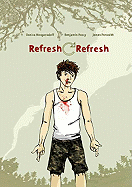
A small town in Oregon serves as a microcosm of war's effects in this powerful graphic novel, as seen through the eyes of three high school seniors. The opening triptych of images sets up the essential contradiction in each of the main characters: a young boy snuggles his puppy in the grass, the puppy licks the boy, then the boy shouts out, "Hit him in the face!" The next spread reveals the boy's older brother, Cody, boxing with Josh, who turns out to be one of Cody's best friends. Yet Josh hits Cody near his left eye with a serious enough punch to draw blood; the third friend, Gordon, eggs them on. They believe these boxing matches toughen them and prepare them for self-defense.
Each of the central characters experiences a bipolar pull toward love and fear, compassion and violence. Danica Novgorodoff's (Slow Storm) scenes takes us inside the households of all three of the characters, and we see that they each experience moments of tenderness--Gordon and Cody with their siblings; Josh with his grandfather; even Gordon with the schoolmate who bullied him--but also violence triggered by anger at their situations and the void left by their absent military fathers. Even the way they resolve their transgressions against the military recruitment officer ends with a paradox. Josh aspires to go to college, while Cody tries to persuade his buddies that all three should enlist together ("The Marines operate in threes… There's three men to a rifle squad. Three rifle squads to a platoon. Three platoons to a company. Three companies to a battalion").
Full-page illustrations, with color by Hilary Sycamore, depict a town with the military recruitment center as its hub, while smaller panels zero in on the teens' homes or step up the pacing in more suspenseful sequences. The palette resembles the muted hues of military camouflage, which makes the red of the boys' boxing gloves and blood pop.
The title, Refresh, Refresh, carries with it a chilling double meaning: no matter how many times they hit the "refresh" button on the computer, no new e-mail messages come in from the teens' fathers, and the cycle in real life, too, seems never to change. Novgorodoff's graphic novel is adapted from a screenplay by James Ponsoldt, which in turn was based on a short story by Benjamin Percy (first published in the Paris Review and included in Best American Short Stories 2006). The graphic novel form is ideally suited to the target audience--if they can find the book in time to hear its message.--Jennifer M. Brown

